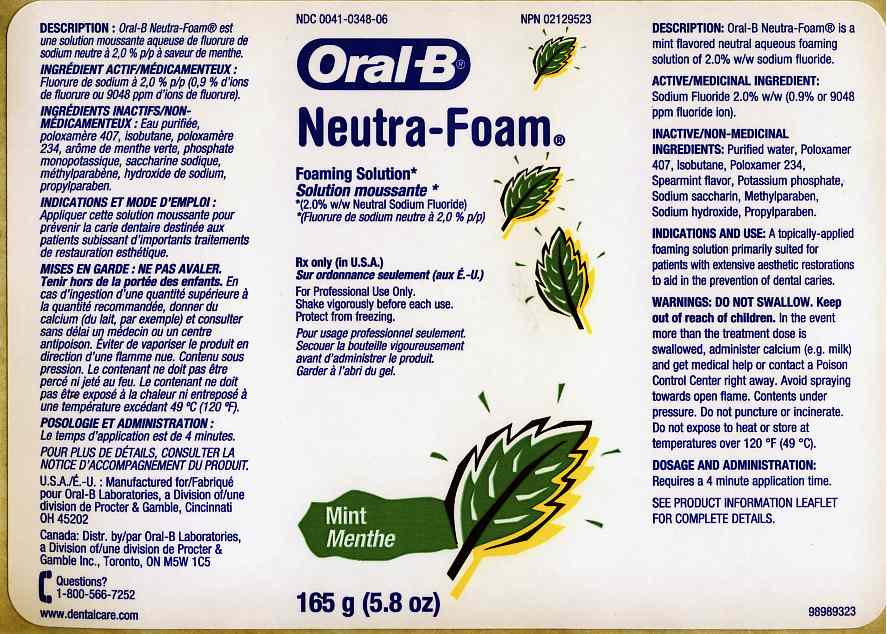Foaming Solution
(2.0% w/w Neutral Sodium Fluoride)
FOR PROFESSIONAL USE ONLY
Active Ingredient:Sodium Fluoride 2.0% w/w (0.9% or 9048 ppm fluoride ion)
• Do not use in patients with dysphagia.
• Accidental ingestion of the usual treatment dose (approximately 9.0 mg of fluoride) is not harmful. In the event more than the treatment dose is swallowed, administer calcium (e.g. milk) and get medical or contact a Poison control Center right away. One bottle of Neutra-Foam contains 1.43 grams of fluoride ion which could be lethal for children and adults.
• Keep out of the reach of infants and children under 12 years.
• Pediatric patients under 12 years of age should be supervised during use of this product.
• Avoid spraying towards open flame.
• Contents under pressure. Do not puncture or incinerate. Do not expose to heat or store at temperatures over 120°F (49°C).
PRECAUTIONS: FOR PROFESSIONAL USE ONLY.
Safety and effectiveness below age 6 have not been established. There have been no long term studies with this product to evaluate carcinogenic, mutagenic or impairment of fertility potential.
Carcinogenesis,
Mutagenesis, Impairment of Fertility:
No evidence of carcinogenicity was observed in female and male mice at doses
ranging from 2.4 to 18.8 mg/kg sodium fluoride of body weight (3,4). Equivocal
evidence of carcinogenicity was reported in male rats at doses ranging from 2.5
to 4.1 mg/kg fluoride, but no evidence of carcinogenicity was observed in
female rats (3,4). In another study, no carcinogenicity was observed in rats
treated with fluoride up to 25 mg/kg of body weight (5). Overall,
epidemiological studies do not show an association between fluoridated drinking
water and increased cancer risk in humans (7).
Potential adverse reproductive effects of fluoride exposure in humans have not been adequately evaluated. Adverse reproductive effects of fluoride have been reported in animal studies, but at high concentrations sufficient to produce other manifestations of toxicity (9).
Geriatric use: No overall differences in safety or effectiveness have been observed between geriatric and younger patients. This drug is known to be substantially excreted by the kidney, therefore the risk of toxic reactions to this drug may be greater in patients with impaired renal function. Because elderly patients are more likely to have decreased renal function, care should be taken in dose selection, and it may be useful to monitor renal function.
ADVERSE REACTIONS: Developing teeth of children under age 6 may become permanently discolored if excessive amounts are repeatedly swallowed. The following adverse reactions are possible in individuals hypersensitive to fluoride: eczema, atopic dermatitis, urticaria, gastric distress, headache and weakness. In patients with mucositis, gingival tissues may be hypersensitive to the flavor.
• Shake bottle vigorously for 3-4 seconds prior to dispensing.
• Invert bottle 180° with nozzle tip pointed downward into tray.
• Place nozzle tip close to the tray floor and at one end of the tray arch.
Moving from one end of the tray to the other in one fluid motion, slowly press down on the trigger. (Note: foam will expand slightly to fill the tray.)
• Do not use excessive finger pressure which could result in too much foam being dispensed.
• Immediately place tray(s) in mouth. (Note: Do not fill trays with foam too far in advance of treatment as the foam will collapse and not be as effective.)
• Have patient bite down on the tray(s) lightly but firmly for up to 4 minutes.
• Remove tray(s) and have patient expectorate.
• Instruct patient not to eat, drink, or rinse for at least 30 minutes. For optimal tooth coverage, use a fluoride applicator tray which is deep enough to reach the entire vertical height of all teeth (even the molars). You can choose from single arch trays (such as CENTRAYS) or dual arch trays (CENTWINS or SOFTWINS).
REFERENCES:
(1.) Wellock, W.D. and Brudevold, F.: Arch. Oral Biol., 10, 453-460 (1965) (2.) Jiang, H et al.: J. Dent, 33, 469-473 (2005) (3.) National Toxicology Program: NTP TR 393, NIH Publication 91-2842, (1990) (4.) Bucker, J.R. et al.: Int. J. Cancer 48, 733-737 (1991) (5.) Maurer, J.K. et al.: J. Natl. Cancer Inst. 82, 1118-1126 (1990) (6) Martin, G.R. et al.: Mutat. Res. 66, 159-167 (1979) (7.) Agency for Toxic Substances and Disease Registry: Toxicological Profile for Fluoride (2003)
(8.) Aardema, M.J. et al.: Mutat. Res. 331 (1), 171-172 (9.) National Research Council: Fluoride in Drinking Water (2006) (10.) Heindel, J.J. et al.: Fundam Appl Toxicol, 30, 162-177 (1996) (11.) Institute of Medicine, Food and Nutrition Board: Dietary Reference Intakes (1997) (12.) Collins, T.F. et al.: Food Chem. Toxicol. 33 (11), 951-960 (13.) Collins, T.F. et al.: Food Chem Toxicol. 39 (8), 867-876
